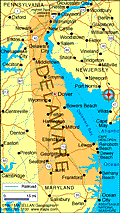 History Henry Hudson, sailing under the Dutch flag, is credited with Delaware's discovery in 1609. The following year, Capt. Samuel Argall of Virginia named Delaware for his colony's governor, Thomas West, Baron De La Warr. An attempted Dutch settlement failed in 1631. Swedish colonization began at Fort Christina (now Wilmington) in 1638, but New Sweden fell to Dutch forces led by New Netherlands' governor Peter Stuyvesant in 1655. England took over the area in 1664, and it was transferred to William Penn as the lower Three Counties in 1682. Semiautonomous after 1704, Delaware fought as a separate state in the American Revolution and became the first state to ratify the Constitution in 1787. During the Civil War, although a slave state, Delaware did not secede from the Union. Delaware also grows a great variety of fruits and vegetables and is a U.S. pioneer in the food-canning industry. Corn, soybeans, potatoes, and hay are important crops. Delaware's broiler-chicken farms supply the big Eastern markets, and fishing and dairy products are other important industries. Points of interest include the Fort Christina Monument, Hagley Museum, Holy Trinity Church (erected in 1698, the oldest Protestant church in the United States still in use), and Winterthur Museum, in and near Wilmington; central New Castle, an almost unchanged late 18th-century capital; and the Delaware Museum of Natural History. Popular recreation areas include Cape Henlopen, Delaware Seashore, Trap Pond State Park, and Rehoboth Beach. |
Read this profile of Delaware to learn about the state's history, points of interest, and government. Also find interesting facts about each state, including the state's motto, symbols, and when it entered the union.




